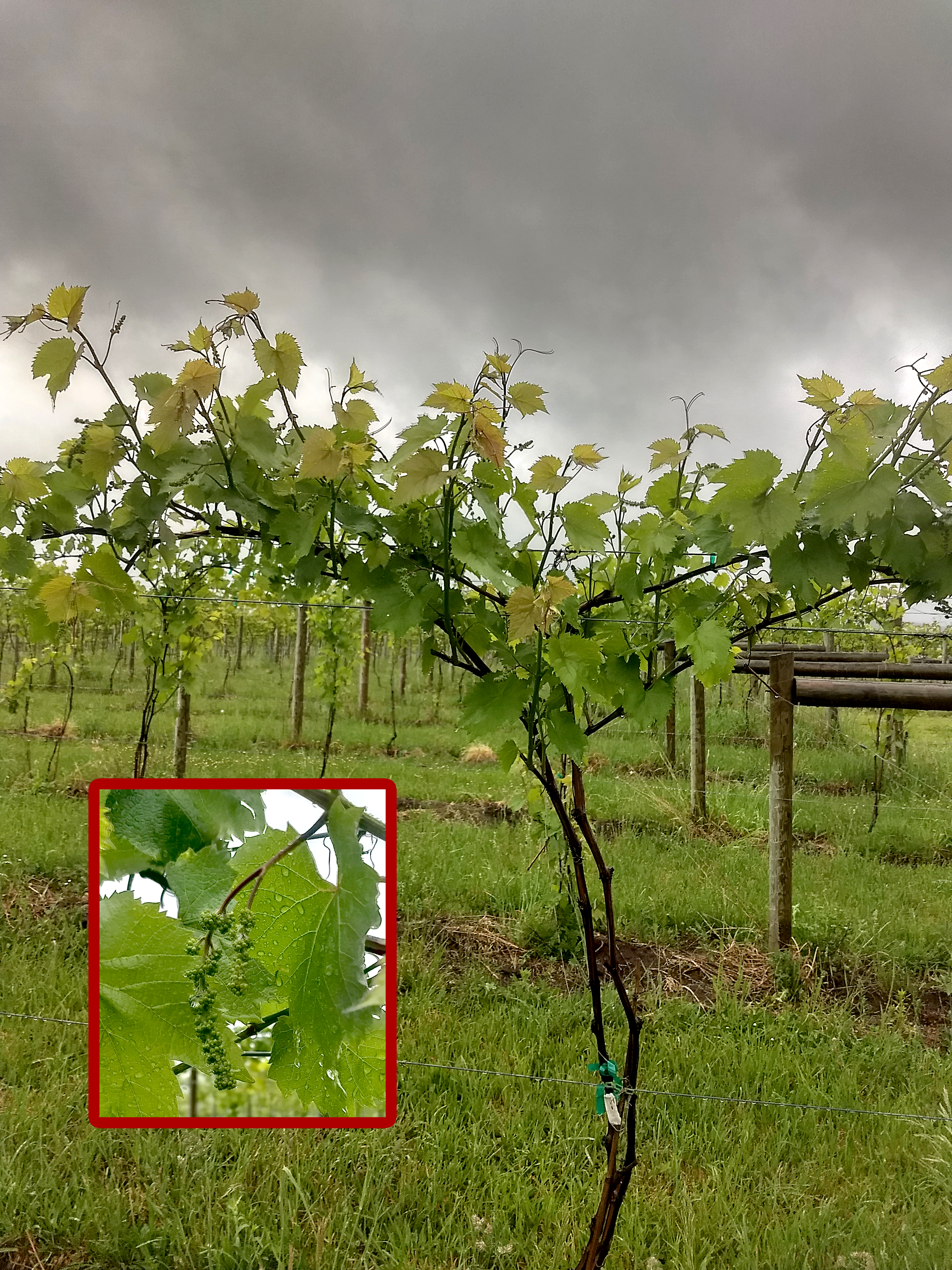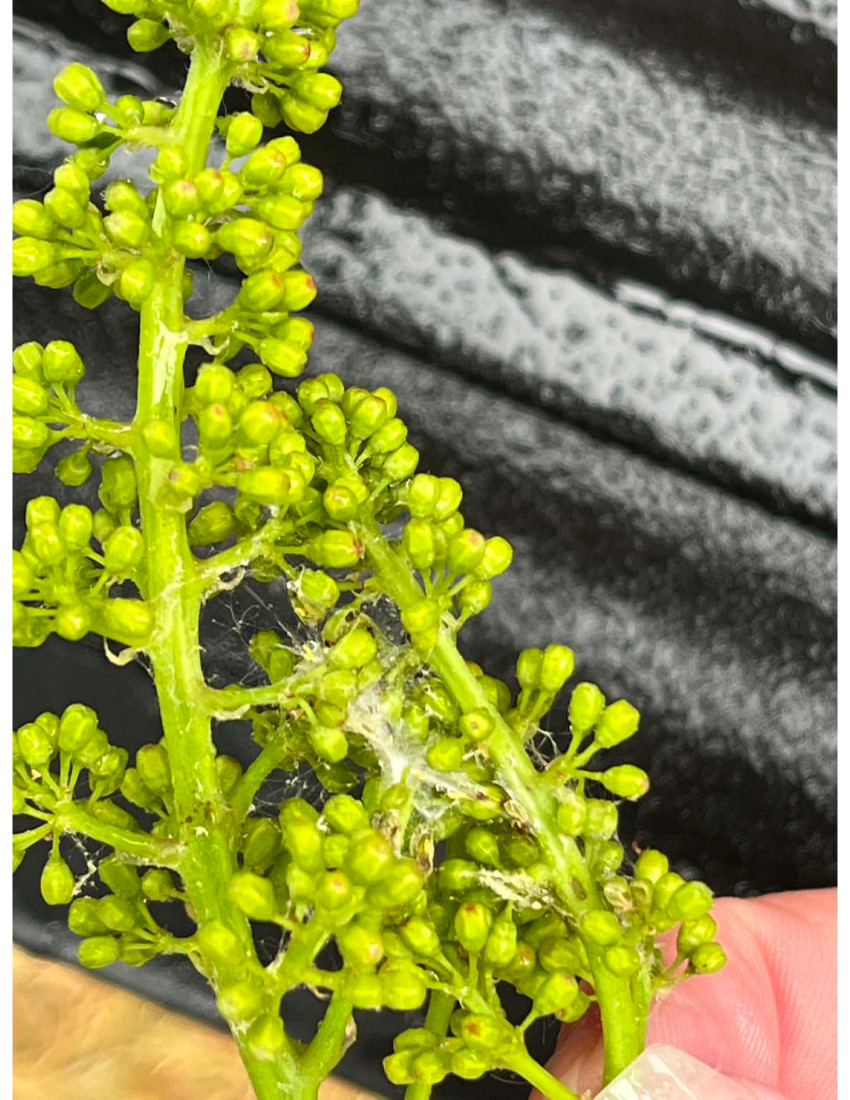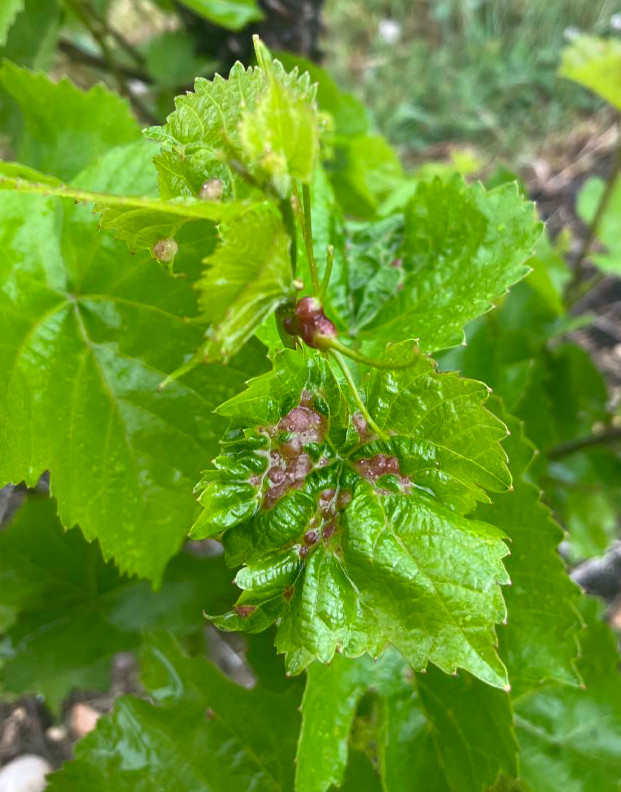Michigan grape scouting report – June 8, 2022
Clusters are expanding in northwest Michigan. Grape bloom is underway in southern parts of the state.

Weather
Last week started hot. All grape growing regions in Michigan saw high temperatures near 90 degrees on Monday. A cold front passed through the state beginning with northern regions on Tuesday and finally exiting the southeast areas by midday on Wednesday. Behind the front, the high temperatures in southern Michigan were in the mid to upper 70s, the upper 60s in northern grape producing regions of the state.
Scattered rain accompanied last week’s cold front. Most parts of the state saw around a tenth of an inch. Several rounds of storms passed through the region between Sunday and yesterday. Northern Michigan got a little over an inch of rain on Monday, southern areas received about the same amount 12-24 hours later.
This week will be cooler. Northern Michigan should see high temperatures in the mid 60s, climbing to 70 by the weekend. Southern Michigan will be about 10 degrees warmer. A storm system will pass through the state later in the day on Wednesday, bringing rain statewide. Another system is expected to bring rain to the southern tier of Michigan on Friday.
With another warmer week, we picked up an above average number of growing degree days: 75-117 GDD base 50. The southwest region is 220 GDD base 50 ahead of the northwest region.
|
Southwest Michigan GDD Summary from March 1 through June 6, 2022 |
|||
|
Enviroweather station |
Current GDD 50 F |
GDD 50 F last week |
Collected the past week |
|
Benton Harbor (SWMREC) |
612 |
480 |
132 |
|
Fennville |
523 |
427 |
96 |
|
Lawton |
596 |
477 |
119 |
|
Average for southwest Michigan |
593 |
480 |
113 |
|
Romeo |
508 |
395 |
113 |
|
Average for southeast Michigan |
548 |
431 |
117 |
|
Old Mission |
370 |
293 |
77 |
|
Petosky |
345 |
274 |
71 |
|
Traverse City (NWMHRS) |
392 |
311 |
81 |
|
Average for northwest Michigan |
375 |
300 |
75 |
Vine growth
In the southwest, in addition to last week’s grape scouting report, Concord, Niagara, Geisenheim 318, and Seyval blanc are now blooming. Other hybrid wine grapes are close to bloom. Many vinifera are a week or more away, especially with the cooler week coming up.
In northern Michigan, clusters are beginning to expand on most vinifera cultivars. Shoot length is either in the 4-8 inch range for the later cultivars or 10-16 inch range for earlier cultivars. Hybrid wine grapes are also around 10-16 inch shoot growth in the Tip of the Mitt region with some at immediate prebloom phase.
Wild grape bloom is recorded and used as the biofix for grape berry moth models. This helps in timing management strategies the rest of the season. In southwest Michigan, wild grape bloom was at 50% early last week or over the weekend before. Wild grape bloom began last Saturday near Traverse City and has spread throughout Grand Traverse County. Many areas in northern Michigan are at or near 50% wild grape bloom now.
See this chart for grape growth stages.

Horticulture
Shoot thinning and trunk cleaning should be underway in many varieties in the southern vineyards. Northern vineyards should begin thinning soon as well. Shoot thinning is an important canopy management tool to improve air circulation, minimize disease pressure, reduce shading, improve spray penetration and ultimately improve fruit quality at harvest. Thin shoots when they are 5-12 inches long and still easy to break off from the woody tissues.
See this article on Early Season Vineyard Management for more information on shoot thinning.
Diseases
At this time of year, the disease focus is on phomopsis, black rot, anthracnose and powdery mildew. For more information on pre bloom fungicide options and the impacts of rain on disease spread, check out this previous grape scouting report or this article on early season disease management.
As bloom approaches in southwest Michigan, start choosing fungicides that control all the fruit diseases. For example with downy mildew we are most concerned with fruit infection at this time and sprays should be timed prior to bloom and at bloom for optimal control. Downy mildew is caused by a fungal-like organism, so many site specific systemic fungicides that target other spring diseases do not work on downy mildew. Effective fungicides for downy mildew include products in FRAC codes 4, 11, 21, 40 and 45 as well as phosphorus acid salts and some biologically-based products.
With the exception of powdery mildew, these spring disease infections typically require rain events. It only takes 0.1 inches of rain above 50 degrees Fahrenheit to trigger a possible infection. Viticultural practices that reduce canopy wetness such as good irrigation timing, leaf removal and good weed management can reduce many of these diseases in a vineyard. Typically, DMIs (FRAC 3), captan and EBDCs (FRAC M3) are effective for phomopsis, black rot, and anthracnose.
Insects
As vineyards move through bloom, the activity of insect pests has been increasing. This week the activity of berry moths remains high in some vineyards based on trap catches, and we have found the first grape berry moth larvae of the season, with webbing in clusters that were just coming into bloom. This lines up with the expected timing of the first generation of berry moth which begins laying eggs during bloom of wild grape and continues through the coming weeks.

In vineyard blocks that had high infestation from grape berry moth last fall, scouting vineyards for berry moth larvae with a focus on areas near woods can determine whether there is significant cluster infestation. If more than 5% of clusters are infested with larvae (evident by their webbing), treatment with an effective insecticide can reduce populations in this early part of the season. See this recent article for more details about grape berry moth management for 2022.
This time of the year is also when we see some other pests starting their activity. In vineyards with a history of grape tumid gallmaker or rose chafer, keep a close eye over the next few weeks on vineyard areas that have been infested previously. Tumid gallmaker is starting to show up on some hybrid wine grapes. For tumid gallmaker, application of Movento or Assail at the first sign of gall formation can help reduce their infestation. Small growers can also physically remove affected shoots and clusters, and dispose of them outside of the vineyard.

Rose chafer activity usually picks up during bloom, so be scouting for these, especially in sandy sites. If they are feeding only on the leaves there is little need for control, except in extreme cases, since vines have the rest of the season to develop the canopy. If feeding is on the clusters, however, those can be protected with an application of insecticide to protect the young clusters. The activity period of rose chafers is quite short, so one application is usually sufficient.
Natural enemies observed in the last week include green lacewings, lady beetles, and predatory stink bugs. This is a good reminder to consider that these insects can provide some level of control in vineyards to maintain some pest populations below thresholds.
Upcoming events
Northwest Michigan Roundtable Discussion on Under-Vine Management Hybrid Meeting. Parallel 45 Vines & Wines and Michigan State University Extension invite grape growers from across Michigan and the Midwest to the Northwest Michigan Roundtable Discussion on Under-Vine Management on June 10 from 3-5 p.m. at Shady Lane Cellars.
The Michigan Grape Society summer Grower’s Social series continues on June 15 with an evening get together at Domaine Berrien. They will be discussing vineyard weed control, vineyard floor management, and how their practices help prevent winter damage. Registration is required to collect a head count for food.
The Southwest Michigan Viticulture Field Day will return to the Southwest Michigan Research and Extension Center for 2022. As tradition holds, the event will be the last Wednesday of July (July 27) and will include presentations of ongoing research in southwest Michigan. The event will once again conclude with a steak dinner and local wine tasting. Registration for the Viticulture Field Day is online through the Michigan Grape Society’s website.
Register for Dirt to Glass 2022: Elevating Michigan Wine from the Ground Up. Michigan State University Extension is hosting a new conference for the Michigan grape and wine industry. Dirt to Glass 2022: Elevating Michigan Wine from the Ground Up is the first ever of its kind in Michigan and this year it will take place in Traverse City on Aug. 25-26. This year's Dirt to Glass conference will focus on soil health, soil identification and soil fertility. Each year, the conference chooses a specific area of study based on the results of an annual educational needs assessment survey. Registration by July 10 is required.
Extracurricular enjoyment
Calling all vineyard pet owners!
Do you have a photogenic vineyard dog or cat?
Maria Smith (OSU), Annie Klodd (UMN), and Cain Hickey (PSU) are assembling a 2023 vineyard pets calendar as a fundraiser for viticulture scholarships, and would like to feature your vineyard pet. This project came about after years of Maria and Annie meeting so many great dogs on their vineyard visits and discussing how fun it would be to have a calendar of them.
The American Society of Enology and Viticulture is seeking to represent pets from across 13 Eastern U.S. states. One pet for each state will be featured each month and one for the cover. If you are interested in having your pet featured on the calendar, please send a high-resolution photo of your pet in the vineyard to Maria Smith (smith.12720@osu.edu). Please include your name, your vineyard name, and your pet’s name along with the photo by June 30 to be considered. Pets of all kinds are welcome!
Calendars will be made available for purchase, and all proceeds will be donated to the American Society of Enology and Viticulture-Eastern Section Scholarship Fund, which supports viticulture and enology students.
Related articles
- 2022 Fruit insecticide registration update
- Southwest Michigan fruit update – June 7, 2022
- Michigan grape scouting report – June 1, 2022
- 2022 MSU Fruit Pest Management Guide (E-154)
- Grape growth stages
- Early season vineyard disease management
- Early season vineyard management
- A Mobile Guide for Grape IPM Scouting in North Central and Eastern U.S.
- Using the MSU Enviroweather grape berry moth model in 2018
This work is supported by the Crop Protection and Pest Management Program [grant no 2021-70006-35450] from the USDA National Institute of Food and Agriculture.



 Print
Print Email
Email